 Oceanic Submersible (1936-43)
Oceanic Submersible (1936-43)WW2 Italian Submarines
Balilla class (1927) | Ettore Fieramosca (1929) | Archimede class (1933) | Glauco class (1935) | Pietro Micca (1935) | Calvi class (1935) | Foca class (1937) | Marcello class (1938) | Brin class (1939) | Liuzzi class (1939) | Marconi class (1940) | Cagni class (1940) | Romolo class (1943)Mameli class (1926) | Pisani class (1928) | Bandiera class (1929) | Squalo class (1930) | Bragadin class (1929) | Settembrini class (1930) | Argonauta class (1931) | Sirena class (1933) | Argo class (1936) | Perla class (1936) | Adua class (1936) | Acciaio class (1941) | Flutto class (1942)
CM class (1943) | CC class (Laid down) | CA class (1942) | CB class (1942)
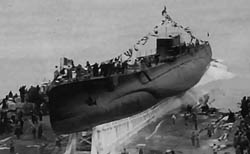 In the wake of the Ettore Fieramosca (1928), and attempt of submarine cruiser, Pietro Micca was the prototype for a new serie of fast and long range submarines, but not cruisers. They were to be much smaller, with a conventional torpedo armament but mine laying capability, as well as enough internal space for spec ops missions with some cargo. Pietro Micca, which remained alone in her class, was designed by Cavallini and built at Tosi shipyard, Taranto, launched on 31 March 1935. She was tested and indeed met design requirements, but deemed to be a too expensive to be repeated. Instead, the Regia Marina ordered the Foca class as pure minelayer subs with 36 instead of 20 mines. #ww2 #regiamarina #pietromicca #submarine #sottomarino #italiannavy
In the wake of the Ettore Fieramosca (1928), and attempt of submarine cruiser, Pietro Micca was the prototype for a new serie of fast and long range submarines, but not cruisers. They were to be much smaller, with a conventional torpedo armament but mine laying capability, as well as enough internal space for spec ops missions with some cargo. Pietro Micca, which remained alone in her class, was designed by Cavallini and built at Tosi shipyard, Taranto, launched on 31 March 1935. She was tested and indeed met design requirements, but deemed to be a too expensive to be repeated. Instead, the Regia Marina ordered the Foca class as pure minelayer subs with 36 instead of 20 mines. #ww2 #regiamarina #pietromicca #submarine #sottomarino #italiannavy
Design of the class
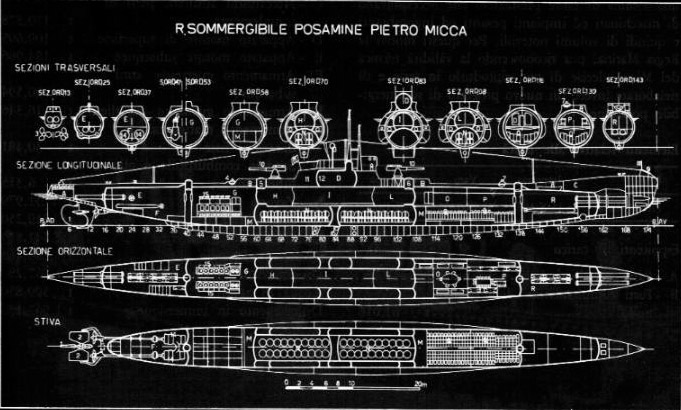
Reconstructed Plans with cutout sections. No CC photos. Credits: See the sources below
Development
After the disappointing result of the Bragadin class, the Regia Marina still had not yet a successful minelayer submarine design, with all the required characteristics. The performances set for the new Micca class program were very ambitious:
-Ability to both lay mines and usable as standard attack submarine with torpedoes
-Having a better surface armament
-Having great speed and superior range
-Having good seakeeping and agility borh surfaced and underwater
-Having a minelaying system which could work well under any circumstances
The challenging design was given to probably the most gifted engineer at the time, Virginio Cavallini, on a “semi-double” hull design of the «Bernardis» type with a single hull but with large blisters, double keel. It turned out to be a good proposal on paper, answering all characteristics. The tradeoff however was its considerable size. It ended not the largest Italian submarine in terms of displacement, but in length at 90 meters. Meeting all the requirements also made it very complex and above all very expensive.
Pietro Micca was laid down at Tosi shipyards on 15 October 1931. She was launched on 31 March 1935. It was not a failure, far from it, but it had limitations, being able to only carrying 20 mines, due to the constraints in speed and range, while being of similar size to the British Porpoise class, which carried 60% more sea mines. Such design, probably too ambitious for its own good, was not sustainable for the budget of the Regia Marina at the time, and was not pursued. Micca remained alone in her class. Instead, it was chosen to tone down some of the requirements for a more moderate design, a development both simpler and cheaper, the Foca class. This one was declined into four boats and considered successful. Micca was also the first Italian submarine equipped with an ultrasonic seeker.
Hull and general design
As said above, Pietro Micca was not the largest Italian sub. Ettore Fieramosca and and the Ballila class were larger in displacement. She displaced 1,371 tons surfaced and 1,883 tons submerged still, but was the longest Italian submarine to date at 296 ft (90 m) but for a narrow beam of 25 ft (7.6 m) and a draught of 17.5 ft (5.3 m). To meet the speed requrement, Cavallini made it slender with a 1/12 hull ratio, which was rare. This made the hull relatively more unstable and agility was less impressive, but this was compensated by several measures, notably larger rudder and dive planes, also placed differently and internal weight repartition for a better balance overall. The way the hull blisters ended below also participated to regain stability.
The upper outer hull, up to the deck, had a preculiar shape for better seakeeping, with curved flanks. The hull blisters also merged forward into the hull by a peculiar curved extension above the forward water scoops. This was a very sculptural hull overall, but quite complex to build, also also participating into the overall cost. The pressure hull was cylindrical, with another cylinder in the outer hull above, below deck and another below amidship containing the mines. The latter were laid from below wells, and Cavallini had to install extra ballasts to keep trim stable due the imbalance caused by the relocated batteries forward.
As all designs of the time she could jettison her ballast keel to regain buoyancy in case of a pump failure.
There was a long conning tower structure with steps fore and aft for the main deck guns. The sail included the classic sheltered bridge with steering wheel, chadburn and repeaters, the CT proper behind with its attack and watch persicopes, and a long platfom ideal to install two twin HMG mounts.
Powerplant
Installed power consisted in two massive 1500 hp tosi diesels engine (locally made at Taranto) rated for 3,000 bhp (2,200 kW) total. Submerged, she was powered by two 800-850 hp Marelli electric motors rated for 1,700 hp (1,300 kW) total, on two shafts. Other sources gives an output of 1600 hp.
Top speed was moderate, 15.5 knots (28.7 km/h) surfaced in the best conditions, 8 to 8.5 knots (15.7 km/h) submerged, which a bit better than older designs. Autonomy was considerable, with a range surfaced of 12 000 nmi a 8 knots and when submerged just 70 nmi a 4 knots. The crew comprised 5 officers, and 58 ratings.
Armament
Armament comprised:
-Two 120mm/45 main deck guns fore and aft of the conning tower on stepped platforms.
-Four 13.2mm Breda heavy machine guns on two twin mounts on the CT platform
-Six 53.3 cm (21″) torpedo tubes (4 bow, 2 stern), 4 in reserve forward, 10 torpedoes total.
-40 mines

Internal Cutaway, original plans. Credits: See the sources below
Main: 120mm/45 OTO Modello 1931
It weighed 3.2 tons, with a barrel elevation of -4° to 32° or 35° on later models. It fire a 22 kg (48.5 ibs) unitary HE shell or 23.15 kgs (51 ibs) AP rounds, which initial muzzle velocity was 730 m/s, range 14,000–14,500 meters at maximum elevation. Its rate of fire was 8 rounds/minute. It used a horizontal sliding block and was common to the Balilla, Fieramosca, Micca and Calvi Classes, so large oceanic submarines.
The 120 mm/45 (4.7″) Model 1931 was a low-powered gun used only on submarines with horizontal sliding block.
The Gun Weight was 3.2 tons (3,484 kg), with a bore lenght of 212.6 in (5.400 m). Rate of fire was 8 rounds per minute. It fired eitehr an HE 48.5 lbs. (22 kg) shell or an AP 51 lbs. (23.15 kg) at a muzzle Velocity of 2,395 fps (730 mps), with an elevation of -4 / +35 degrees giving a range of 15,860 yards (14,500 m).
AA: 2×2 Breda Modello 31
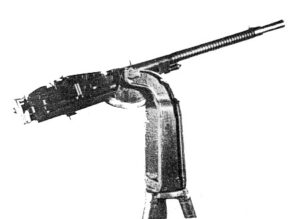
The anti-aircraft defence counted on two twin Breda M1931 13.2 mm L/76 heavy machine guns, placed on rea platform of the conning tower. Each mount weighed 695 kg, but ensired an elevation of -10° to 90°. They fired 125 g unitary rounds, with a muzzle velocity of 790 m/s, maximum range of 6,000 meters and effective range of 2,000 meters. Their rate of fire was 500 rounds/min, so 2000 rounds when both twin mounts fired in concert however.
533 mm torpedoes
Model unknown. When completed it had models powered by wet-heaters:
-W 270/533.4 x 7.2 Veloce: 1,700 kg, 7.2 m WH 270 kg, 3,000-4,000 m/50 knots or 12,000 m/30 knots.
-W 270/533.4 x 7.2 “F”: 1,550 kg, 6.500 m, WH 250 kg, speed 3,000 m/43 knots or 10,000 m/28 knots
-W 250/533.4 x 6.5: 1,550 kg, 7.200 m, WH 270 kg, 4,000 m/48 knots or 12,000 m/30 knots.
-Si 270/533.4 x 7.2 “I”: 1,700 kg, 7.2 m, WH 270 kg, speed 3 km/42 kts or 7 km/32 kts, 9,2km/30 knots, 12km/26 kts
-W 250/533.4 x 6.72: 7.2m, WH 270 kg speed 4km/49 kts or 8km/38 kts.
-Si 270/533.4 x 7.2 “M”: 1,7 ton, 7.2 m, WH 270 kg speed 4km/46 kts, 8km/35 kts or 12km/29 kts.
She was given also a pair of hydrophones.
P150 and P150/1935 Mines
These mines were manufactured by Pignone, specifically designed to be laid by submarines such as the Foca, Micca and Bragadin classes. Their warhead was either 265 or 331 lbs. (120 or 150 kg) and they had mooring cables 990 feet (300 m) long. On Micca they were located amidship, in a second half-cylindrical outer hull below, in short wells, two rows of ten in a forward chamber and the same aft. They were guided by sloped chutes to pass the axial double keel.

Author’s rendition of the Micca in 1943
⚙ specifications |
|
| Displacement | 1,371 tons surfaced, 1,883 tons submerged |
| Dimensions | 90 x 7.6 x 5.3m (296 x 25 x 17.5 ft) |
| Propulsion | 2 shafts 3,000 bhp Tosi diesels, 2x 1600 shp Marelli EM |
| Speed | 15.5 knots (28.7 km/h; 17 mph) surfaced, 8.5 knots (15.7 km/h; 9.2 mph) submerged |
| Range | 5,000 nmi/9 knots surfaced, 70? nmi/4 knots submerged |
| Armament | 2x 120 mm/45 (5 in) deck guns, 4× 13.2 mm AA MG, 6× 533 mm TTs (4 bow, 2 stern), 40 mines |
| Test depth | 100 m (330 ft) |
| Crew | 72 |
Career of Pietro Micca
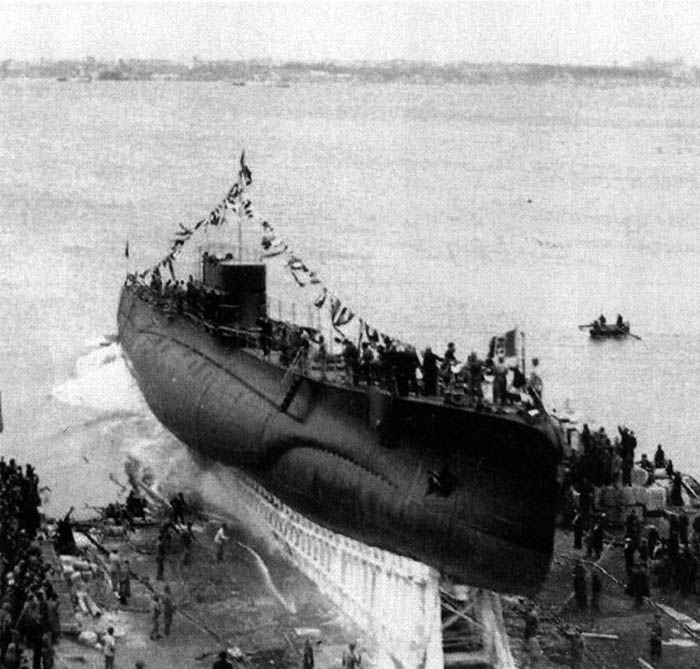
Launch in 1935. No CC photos. Credits: See the sources below
Pietro Micca was commissioned on 1 October 1935. She was assigned to the IV Submarine Group. Her first missions were Spanish Civil War patrols in support of Francisco Franco. on 23 January and 13 February 1937. These two clandestine missions were performed under command of Lieutenant Commander Ernesto Forza. In the first, she left on 23 January 1937, patrolled the waters off Valencia without identifying suspicious ships, returned on 2 February. In the second from 13 February 1937, she received a message to abort mission the following day due to the suspension of the underwater offensive, return of all units was ordered by the naval staff.
As the largest Regia Marina submarine, Pietro Micca led the Italian submarine fleet on 5 May 1938 in th bay of Naples during a naval parade organized for Adolf Hitler by Mussolini. Miccawas then still commanded by Forza on this unique assembly of 85 submarines “showing off” a simultaneous dive followed by a short underwater navigation, surfacing and coordinated salvoes with their guns. At the time Germany had only a bunch of coastal submarines. Italy had the world’s largest second fleet besides USSR.
Micca was at sea when Italy declared war. She was alreadyon a mission for a week and on the night of 12 June she laid 40 mines near Alexandria in Egypt.
She returned to lay a second minefield off Alexandria on 12 August as well under command of frigate captain Alberto Ginocchio by night. She stayed on faction for opportunity targets and on the 14th she spotted launched torpedos from her stern tubes, from a short distance, against two incoming British destroyers sailing 90 miles northwest of Alexandria. A detonation was heard but no kill confirmation.
Italy kept Pietro Micca in the Mediterranean, despite Kriegsmarine’s requests for a temporary assignment to BETASOM (in Bordeaux). Given her abilities and range, Karl Dönitz wanted to have her deployed for minelaying mission at Freetown, Cape Town, and Madagascar. In fact, the Kriegsmarine lacked minelayer submarines with enough autonomy, while Micca could have easily reached Freetown without issue. The Regia Marina objected the transfer since the Bordeaux base did not have suitable facilities for a minelayer submarine, and because Micca was considered more useful to transport supplies acorss the Mediterranean, especially since she was designed for this from the start, and because the situation in North Africa radically changed.
She was further modified in order to carry food, gasoline and ammunition to the Aegean Sea and North Africa. These became her primary missions by the end of 1940.
Starting in February 1941 under Lieutenant Commander Guido d’Alterio she carried out various transport missions, 15 in all with a total of 2,163 tons of supplies between Libya and the Aegean. On 13 March 1941 she spotted destroyers, launched but missed. At the beginning of April 1941 while sailing from Taranto to Leros, she spotted a British convoy south of Crete. She close to take position and attacked, launching two torpedoes from 1,500 meters. Two explosions were heard but there were no confirmations. She escaped the area submerged. While entering Leros on 5 April, she was seriously damaged by a torpedo explosion which slipped out from one of the stern tubes and impacted the bottom or another sources pounts out instead a mine detonation, albeit it’s very unlikely. Stull, she lost all power and flooding was contained, she was towed to port, and after the first emergency repairs she was sent to Taranto for major repairs from June to November 1941.
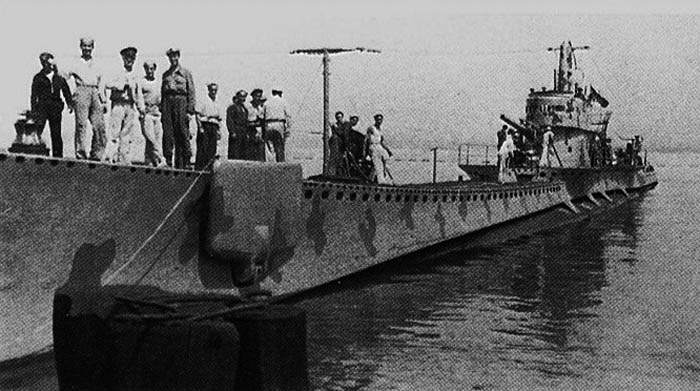
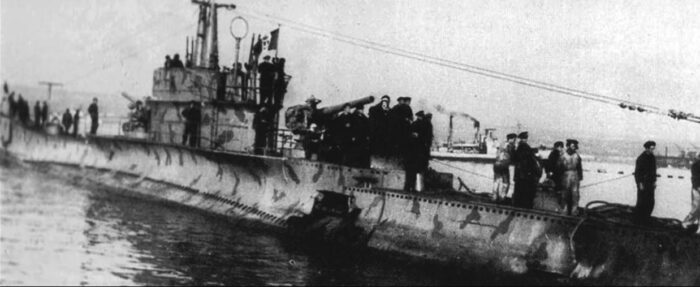
Micca in her 1942 camouflage of olive green of light grey. No CC photos. Credits: See the sources below
In July 1941 she was seriously damaged by a violent storm, loosing while surfaced Petty Officer Giuseppe Canta (bronze medal for military valor) wounded in a raid and after trying to put out a fire started by debris from the short down aircraft close to her decks, was thrown overboard by the explosion. Micca resumed her transport missions, and by mid-December 1941, Alberto Galeazzi took commad. In 1942 she was detached from her transport runs for a patrol near Malta, but without results. The remainder of the year went on uneventfully as the first sis months of 1943. On 15 June 1943, Lieutenant Paolo Scrobogna took command.
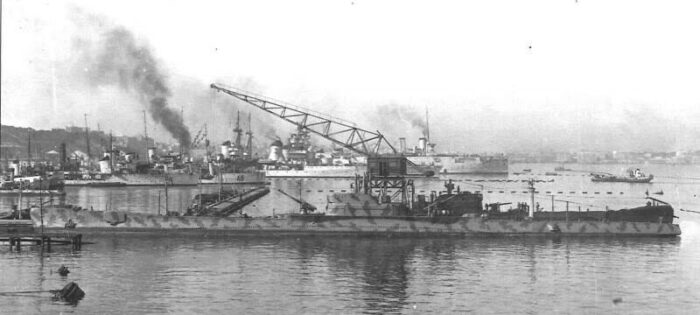
Allegedly Micca in Taranto 8 Feb. 1941. No CC photos. Credits: See the sources below
On 24 July 1943 she set sail from Taranto bound for Naples. Four days later in the evening, she suffered an engine breakdown off Capo Spartivento Calabro and reversed course home. She was supposed to rendezvous off Santa Maria di Leuca with her escort, the Bormio, but was spotted underway by the T class submarine HMS Trooper. At 6:05 on 29 July the latter launched six torpedoes. One hit Micca amidships. This apparently was strng enough to ruprure the pressure hull and she sank with (almost) all hands 3 miles at 207° from the lighthouse of Santa Maria di Leuca. Other sources reported that she first dodged two torpedoes, but was hit by a third when reversing course). As she was surfaced when it happened,
Commander Scrobogna and 17 officers, petty officers and sailors were thrown or jumped overboard, later rescued by fishing boats from Bormio. Two officers, 62 petty officers and sailors plus a civilian yard worker were on board and disappeared with the submarine.
It seems that part of the crew trapped in the wreck under 72 meters survived for 48h as underwater noises were according to some fishermen, with shots heard on the third day. Since the RM had no submarine safety procedures for retrieval in emergency, the suvivors died. In WW2 she had performed 24 war missions, four offensive sorties, 14 transport missions, 2 mine-laying missions, 4 training or transfer trips for a total of 23 140 nmi. Her wreck was located in 1994 three miles from the coast, between 80 and 85 meters deep (shee slipped further down with currents) and was explored. The theory of a catastrophic flooding amidship was confirmed but it seems her aft compartment held indeed.
Read More/Src
Books
Conway’s all the world’s fighting ships 1922-46
Campbell, John (1985). Naval Weapons of World War Two. Annapolis, Maryland: Naval Institute Press.
Fontenoy, Paul E. (2007). Submarines: An Illustrated History of Their Impact. Santa Barbara, California: ABC-CLIO.
Fraccaroli, Aldo (1968). Italian Warships of World War II. Shepperton, UK: Ian Allan.
Kafka, Roger; Pepperburg, Roy L. (1946). Warships of the World. Cornell Maritime Press.
Franco Bargoni, L’Impegno Navale Italiano durante La Guerra Civile Spagnola (1936-1939), Roma, Ufficio Storico della Marina Militare, 1992
Giorgio Giorgerini, Uomini sul fondo. Storia del sommergibilismo italiano dalle origini a oggi, Segrate, Arnoldo Mondadori Editore, 2002
Alessandro Turrini e Ottorino O. Miozzi, Sommergibili italiani, Roma, Ufficio Storico della Marina Militare, 1999.
Links
web.archive.org/ masgrupsom.com/ micca.html
relitti.it/ PIETRO MICCA
web.archive.org dilietoangelo.it
web.archive.org/ www.anmibari.it/storia.htm
on trentoincina.it/
regiamarina.ne submarines-class-type-cavallini/
on issuu.com rivista.militare
Full and detailed logs on uboat.net
sommergibili.com/micca.htm
micello.it/ sommergibile-pietro-micca/
betasom.it/ classe-micca-1931/
on en.wikipedia.org/
web.archive.org/ on youtube.com
on betasom.it/ forum
Model Kits
None

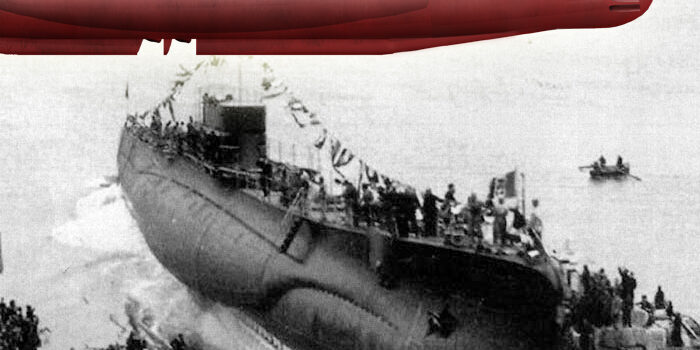
 Latest Facebook Entry -
Latest Facebook Entry -  X(Tweeter) Naval Encyclopedia's deck archive
X(Tweeter) Naval Encyclopedia's deck archive Instagram (@navalencyc)
Instagram (@navalencyc)





 French Navy
French Navy Royal Navy
Royal Navy Russian Navy
Russian Navy Armada Espanola
Armada Espanola Austrian Navy
Austrian Navy K.u.K. Kriegsmarine
K.u.K. Kriegsmarine Dansk Marine
Dansk Marine Nautiko Hellenon
Nautiko Hellenon Koninklije Marine 1870
Koninklije Marine 1870 Marinha do Brasil
Marinha do Brasil Osmanlı Donanması
Osmanlı Donanması Marina Do Peru
Marina Do Peru Marinha do Portugal
Marinha do Portugal Regia Marina 1870
Regia Marina 1870 Nihhon Kaigun 1870
Nihhon Kaigun 1870 Preußische Marine 1870
Preußische Marine 1870 Russkiy Flot 1870
Russkiy Flot 1870 Svenska marinen
Svenska marinen Søværnet
Søværnet Union Navy
Union Navy Confederate Navy
Confederate Navy Armada de Argentina
Armada de Argentina Imperial Chinese Navy
Imperial Chinese Navy Marinha do Portugal
Marinha do Portugal Mexico
Mexico Kaiserliche Marine
Kaiserliche Marine 1898 US Navy
1898 US Navy Sovietskiy Flot
Sovietskiy Flot Royal Canadian Navy
Royal Canadian Navy Royal Australian Navy
Royal Australian Navy RNZN Fleet
RNZN Fleet Chinese Navy 1937
Chinese Navy 1937 Kriegsmarine
Kriegsmarine Chilean Navy
Chilean Navy Danish Navy
Danish Navy Finnish Navy
Finnish Navy Hellenic Navy
Hellenic Navy Polish Navy
Polish Navy Romanian Navy
Romanian Navy Turkish Navy
Turkish Navy Royal Yugoslav Navy
Royal Yugoslav Navy Royal Thai Navy
Royal Thai Navy Minor Navies
Minor Navies Albania
Albania Austria
Austria Belgium
Belgium Columbia
Columbia Costa Rica
Costa Rica Cuba
Cuba Czechoslovakia
Czechoslovakia Dominican Republic
Dominican Republic Haiti
Haiti Hungary
Hungary Honduras
Honduras Estonia
Estonia Iceland
Iceland Eire
Eire Equador
Equador Iran
Iran Iraq
Iraq Latvia
Latvia Liberia
Liberia Lithuania
Lithuania Mandchukuo
Mandchukuo Morocco
Morocco Nicaragua
Nicaragua Persia
Persia San Salvador
San Salvador Sarawak
Sarawak Uruguay
Uruguay Venezuela
Venezuela Zanzibar
Zanzibar Warsaw Pact Navies
Warsaw Pact Navies Bulgaria
Bulgaria Hungary
Hungary

 Bundesmarine
Bundesmarine Dutch Navy
Dutch Navy Hellenic Navy
Hellenic Navy Marina Militare
Marina Militare Yugoslav Navy
Yugoslav Navy Chinese Navy
Chinese Navy Indian Navy
Indian Navy Indonesian Navy
Indonesian Navy JMSDF
JMSDF North Korean Navy
North Korean Navy Pakistani Navy
Pakistani Navy Philippines Navy
Philippines Navy ROKN
ROKN Rep. of Singapore Navy
Rep. of Singapore Navy Taiwanese Navy
Taiwanese Navy IDF Navy
IDF Navy Saudi Navy
Saudi Navy Royal New Zealand Navy
Royal New Zealand Navy Egyptian Navy
Egyptian Navy South African Navy
South African Navy






























 Ukrainian Navy
Ukrainian Navy dbodesign
dbodesign